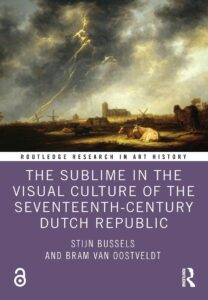The Sublime in the Visual Culture of the Seventeenth-Century Dutch Republic written by our colleagues Stijn Bussels and Bram Van Oostveldt is now published by Routledge.
At the end of the month the paper version will be ready. In the meantime, you can find out more and access the book here
Abstract
Contrary to what Kant believed about the Dutch (and their visual culture) as “being of an orderly and diligent position” and thus having no feeling for the sublime, this book argues that the sublime played an important role in seventeenth-century Dutch visual culture.
This book argues that in seventeenth-century Dutch visual culture the sublime played an important role, thus moving beyond traditional and still widespread views of Dutch art as the ultimate representation of everyday life. It is aimed at readers who want to broaden their view on the world of artists such as Rembrandt and Aelbert Cuyp, architects such as Jacob van Campen, and writers such as Joost van den Vondel and Constantijn Huygens, as well as readers who want to know the early history of the sublime. Dutch humanists’ interest in Longinus’s On the Sublime, which was early and groundbreaking, made the sublime a fertile category for studying the creation and impact of art, architecture, and theater. The Dutch reception of Longinus must be related to neighboring concepts, namely the Ovidian sublimis, le merveilleux, the fear of God, magnificence, terrifying sublimity, and wonder. All of these concepts deal with an overwhelming impact that goes far beyond the ordinary and leads to ecstasy, admiration, and astonishment. By relating these ideas to Dutch representations of extraordinary heights, divine presence, political grandeur, extreme violence, and amazing artifacts, we see how viewers were confronted with contrasting feelings of awe and fear, attraction and repulsion.
